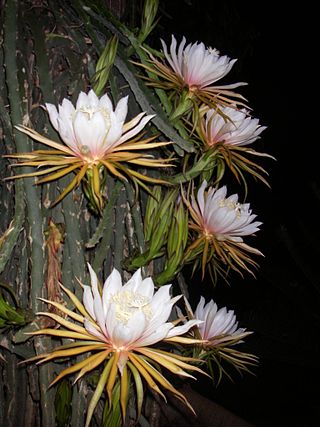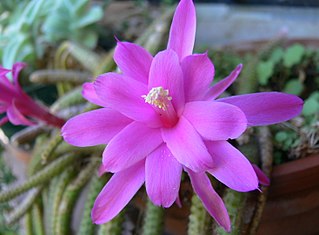
Rapicactus is a genus of cactus in the tribe Cacteae, subfamily Cactoideae. It has been synonymized with Turbinicarpus but molecular phylogenetic studies have supported its monophyly and separation from that genus.

Disocactus is a genus of epiphytic cacti in the tribe Hylocereeae found in Central America, the Caribbean and northern South America. It should not be confused with Discocactus, which is a different genus.

Aporocactus is a genus of cacti in the tribe Hylocereeae native to Mexico. It used to be classified as a subgenus in Disocactus, but according to molecular evidence, it should be excluded from Disocactus and treated as a separate genus.

Hylocereus is a former genus of epiphytic cacti, often referred to as night-blooming cactus. Several species previously placed in the genus have large edible fruits, which are known as pitayas, pitahayas or dragonfruits. In 2017, a molecular phylogenetic study confirmed an earlier finding that the genus Hylocereus was nested within Selenicereus, so all the species of Hylocereus were transferred to Selenicereus.

Selenicereus, sometimes known as moonlight cactus, is a genus of epiphytic, lithophytic, and terrestrial cacti, found in Mexico, Central America, the Caribbean and northern South America. The term night-blooming cereus is also sometimes used, but this is also used for many night-blooming cacti, including Epiphyllum and Peniocereus. In 2017, the genus Hylocereus was brought into synonymy with Selenicereus. A number of species of Selenicereus produce fruit that is eaten. The fruit, known as pitaya or pitahaya in Spanish or as dragon fruit, may be collected from the wild or the plants may be cultivated.

Pseudorhipsalis is genus of cacti. This genus is often included in Disocactus. It is epiphytic, many branched, and elongated with flattened, serrated cladodes. In its early life, it stands erect, but soon becomes prostrate. It produces numerous flowers.

Deamia is a genus of cacti. Its species are native from south Mexico through Central America to Nicaragua. Its species have been placed in Selenicereus and Strophocactus.

The Cactoideae are the largest subfamily of the cactus family, Cactaceae. Around 80% of cactus species belong to this subfamily. As of August 2018, the internal classification of the family Cactaceae remained uncertain and subject to change. A classification incorporating many of the insights from the molecular studies was produced by Nyffeler and Eggli in 2010. Various revisions have been published since, e.g. to the tribe Hylocereeae and the tribe Echinocereeae. Classifications remained uncertain as of March 2019.

Aporocactus flagelliformis, the rattail cactus, is a species of flowering plant in the cactus family Cactaceae, and is the most cultivated species in the genus Aporocactus. Due to its ease of cultivation and attractive floral displays, it is often grown as an ornamental potted plant.

Selenicereus costaricensis, synonym Hylocereus costaricensis, known as the Costa Rican pitahaya or Costa Rica nightblooming cactus, is a cactus species native to Central America and north-eastern South America. The species is grown commercially for its fruit, called pitaya or pitahaya, but is also an impressive ornamental vine with huge flowers. The species may not be distinct from Selenicereus monacanthus.

Aporocactus martianus is a species of cactus found in Oaxaca, Mexico.

Strophocactus brasiliensis, synonym Pseudoacanthocereus brasiliensis, is a species of plant in the family Cactaceae. It is endemic to Brazil. Its natural habitats are subtropical or tropical dry forests and hot deserts. It is threatened by habitat loss.

The Hylocereeae are a tribe of cacti. Most are found in the tropical forests of Central and northern South America, and are climbers or epiphytes, unlike most cacti. The tribe includes between six and eight genera in different circumscriptions. The plants known as "epiphyllum hybrids" or "epiphyllums", widely grown for their flowers, are hybrids of species within this tribe, particularly Disocactus, Pseudorhipsalis and Selenicereus, less often Epiphyllum, in spite of the common name.

Epiphyllum hybrids, epiphyllums, epicacti, or just epis, also known as orchid cacti, which are widely grown for their flowers, are artificial hybrids derived primarily from species of the genus Disocactus. These Disocactus species are not true epiphyllums, but they used to be included in the genus Epiphyllum.
Strophocactus sicariguensis, synonym Pseudoacanthocereus sicariguensis, is a species of plant in the family Cactaceae. It is native to Colombia and Venezuela. It has often sprawling thin stems and white funnel-shaped flowers that open at night.
Deamia chontalensis is a species of flowering plant in the family Cactaceae, native to southwestern Mexico and Guatemala. It has sprawling or pendent branched stems and fragrant white flowers.

Deamia testudo is a species of flowering plant in the family Cactaceae, native from southern Mexico through Central America to Nicaragua. It was first described in 1838. It is a climber or clamberer, with long stems and large white flowers.

The Echinocereeae are a tribe of cacti in the subfamily Cactoideae. Since 2006, the tribe has included the former tribe Pachycereeae in many treatments of cactus classification. The exact circumscription of the tribe has been subject to considerable change, particularly since molecular phylogenetic approaches have been used in determining classifications, and remains uncertain. The tribe includes large treelike species, such as the saguaro, as well as shorter shrubby species. Most members of the tribe are found in desert regions, particularly in Mexico and the southwestern United States.

Kadenicarpus is a genus of flowering plants belonging to the family Cactaceae. It is native to eastern Mexico. It has been synonymized with Turbinicarpus but molecular phylogenetic studies have supported its monophyly and separation from that genus.

Epiphyllum chrysocardium is an epiphytic cactus native to Mexico, commonly called fern leaf cactus, golden heart epiphyllum, shark tooth cactus and shark fin cactus.



















